Prescription Stimulant Addiction: Types and Treatment Options



Jacquelyn Buffo is a fully Licensed Professional Counselor through the State of Michigan and a Certified Advanced Alcohol and Drug Counselor. She received her Master’s Degree in Mental Health Counseling from Capella University.

Dr. Scot Thomas received his medical degree from the University of California, San Diego School of Medicine. During his medical studies, Dr. Thomas saw firsthand the multitude of lives impacted by struggles with substance abuse and addiction, motivating him to seek a clinical psychiatry preceptorship at the San Diego VA Hospital’s Inpatient Alcohol and Drug Treatment Program.




Jacquelyn Buffo is a fully Licensed Professional Counselor through the State of Michigan and a Certified Advanced Alcohol and Drug Counselor. She received her Master’s Degree in Mental Health Counseling from Capella University.

Dr. Scot Thomas received his medical degree from the University of California, San Diego School of Medicine. During his medical studies, Dr. Thomas saw firsthand the multitude of lives impacted by struggles with substance abuse and addiction, motivating him to seek a clinical psychiatry preceptorship at the San Diego VA Hospital’s Inpatient Alcohol and Drug Treatment Program.
Many prescription stimulants are medications prescribed primarily to treat attention-deficit hyperactivity disorder (ADHD).1 With effects like increased alertness and energy, they can also be prescribed to treat narcolepsy.2
Some prescription stimulants are amphetamines which, in addition to their therapeutic effects, may increase blood pressure, body temperature, and pulse rate.3 Despite their therapeutic value, prescription amphetamines are commonly misused for non-medical reasons. Misuse can increase the risk of becoming addicted to amphetamines, also known as a stimulant use disorder.1,2
What is Prescription Stimulant Addiction?
A prescription stimulant or amphetamine addiction develops as compulsive misuse begins to negatively impact various areas of a person’s life including health issues and a failure to fulfill work and school responsibilities.1
Misuse of a prescription stimulant can begin as a person:1
- Takes medicine in a different way or dose than prescribed.
- Takes someone else’s medicine.
- Takes medicine only for the euphoric effects it causes.
In some cases, prescription amphetamine misuse involves the drugs being used in unintended ways like injecting, smoking, or snorting in an attempt to produce a more sudden, or instant rush.4 The rewarding stimulant rush is desirable for many people and reinforces the misuse potential of amphetamines and other prescription stimulants.4
Statistics on prescription stimulant misuse include:
- The rates of prescription stimulant misuse are highest amongst young adults between the ages of 18 and 25.5
- In 2019, more than 45% of young adults who used prescription stimulants also misused them for non-medical purposes.5
- In 2019, 0.6% of young adults had a prescription stimulant use disorder at some point in the past year.5
- An estimated 5.1 million people reported misusing prescription stimulants in 2021.6
Types of Prescription Stimulants
Common prescription stimulants include:1,3
- Ritalin
- Concerta
- Adderall
- Dexedrine
Ritalin
Ritalin is methylphenidate, which is an FDA-approved medication to treat ADHD in both adults and children. It is a second-line treatment for narcolepsy.7,8 Ritalin is a central nervous system (CNS) stimulant that increases the activity of dopamine and norepinephrine in the brain.7,8 Ritalin is available in two orally administered formulations. In 2021, approximately 0.5% of high school seniors reported misusing Ritalin within the past year.6
Concerta
Like Ritalin, Concerta is a brand formulation of methylphenidate used to treat ADHD; however, Concerta is available as an extended-release medication.9Concerta misuse may sometimes include crushing or chewing the tablets to bypass the extended-release mechanism.9 Concerta is a Schedule II substance, due to its potential for misuse and dependence.9
Adderall
Adderall is a prescription stimulant that includes a combination of dextroamphetamine and amphetamine to treat ADHD and narcolepsy.10 Like other prescription stimulants, there is a high potential for misuse, which could lead to Adderall addiction.10 Because of this, Adderall should be used only as prescribed. As of 2020, an estimated 1.8% of high school seniors reported misusing Adderall in the past year.6
Dexedrine
Dexedrine is another stimulant medication that includes a dextroamphetamine/amphetamine combination. Dexedrine is also prescribed to treat narcolepsy and ADHD.11 Dexedrine is available as an extended-release medication, which should only be taken as recommended by a doctor. Like the other stimulants mentioned, it has a high potential for misuse which can increase the likelihood of someone becoming addicted to Dexedrine.11
Desoxyn
Desoxyn is a prescription form of methamphetamine indicated for ADHD treatment; though it is a pharmaceutical formulation of methamphetamine, like its illicit counterpart, it does carry several risks including a high potential for misuse.12 It has very limited use in the United States.12
Dangers of Prescription Stimulant Addiction
Prescription stimulant addiction and compulsive misuse can be dangerous. Some mental and physical health risks associated with prescription amphetamine stimulants include:1
- Anger and aggression.
- Psychotic symptoms such as paranoia, hallucinations, and delusions.
- Cardiovascular issues such as arrhythmia, blood pressure changes, heart attack, and stroke.
- Dangerously elevated body temperature.
- Nausea, vomiting, and diarrhea.
- Tremors and convulsions.
- Coma.
- Overdose-related death.
Some of the health risks associated with prescription stimulant use may become more severe over time and/or when used at higher doses.1
Prescription Stimulant Addiction Treatment Programs
Addiction is a complex and chronic condition, but it can be managed with treatment.13 If you are struggling with stimulant use disorder or addiction to any other substance, help is available. Effective addiction treatment should focus on creating individualized treatment plans to meet your needs and should be regularly evaluated and modified as you progress in recovery.13
There are several different treatment settings and interventions available for stimulant addiction, such as:13
- Inpatient drug rehab.
- Outpatient rehab programs.
- Behavioral therapy.
- Rehab aftercare.
If you or a loved one is ready to seek rehab for a substance use disorder, explore your options and reach out to a rehab center using our rehab directory tool today!
-
National Institute on Drug Abuse. (2018, June 6). Prescription stimulants: Drugfacts. https://nida.nih.gov/publications/drugfacts/prescription-stimulants
-
Martin D, Le JK. (Updated 2022 Aug 1). Amphetamine. In: StatPearls [Internet]. Treasure Island (FL): StatPearls Publishing; 2022 Jan-. https://www.ncbi.nlm.nih.gov/books/NBK556103/#:~:text=Amphetamine%20is%20a%20medication%20used,in%20treating%20ADHD%20and%20narcolepsy.
-
Substance Abuse and Mental Health Services Administration. (n.d.). Prescription stimulant misuse and prevention among youth and young adults. https://store.samhsa.gov/sites/default/files/SAMHSA_Digital_Download/PEP21-06-01-003.pdf
-
National Institute on Drug Abuse. (2020). Misuse of prescription drug research report: What is the scope of prescription drug misuse in the United States?. https://nida.nih.gov/publications/research-reports/misuse-prescription-drugs/what-scope-prescription-drug-misuse#:~:text=How%20many%20young%20students%20misuse,in%20the%20past%2012%20months.
-
Abdijadid, S. & Verghese, C. (2022). Methylphenidate. StatPearls [Internet]. Treasure Island (FL): StatPearls Publishing. https://www.ncbi.nlm.nih.gov/books/NBK482451/
-
Novartis Pharmaceuticals Corporation. (n.d). Ritalin. https://www.accessdata.fda.gov/drugsatfda_docs/label/2013/010187s077lbl.pdf
-
U.S. Food and Drug Administration. (n.d.). Concerta. https://www.accessdata.fda.gov/drugsatfda_docs/label/2007/021121s014lbl.pdf
-
U.S. Food and Drug Administration. (n.d.). Adderall. https://www.accessdata.fda.gov/drugsatfda_docs/label/2007/011522s040lbl.pdf
-
Marwaha, R., Molla, M., & Shoar, N.S. (2022). Dextroamphetamine-amphetamine. StatPearls [Internet]. Treasure Island (FL): StatPearls Publishing. https://www.ncbi.nlm.nih.gov/books/NBK507808/
-
Recordati Rare Diseases Inc. (2019, March). Desoxyn. https://www.accessdata.fda.gov/drugsatfda_docs/label/2022/005378s037lbl.pdf
-
National Institute on Drug Abuse. (2019). Treatment approaches for drug addiction: Drugfacts. https://nida.nih.gov/publications/drugfacts/treatment-approaches-drug-addiction
Our Promise
How Is Recovery.com Different?
We believe everyone deserves access to accurate, unbiased information about mental health and recovery. That’s why we have a comprehensive set of treatment providers and don't charge for inclusion. Any center that meets our criteria can list for free. We do not and have never accepted fees for referring someone to a particular center. Providers who advertise with us must be verified by our Research Team and we clearly mark their status as advertisers.
Our goal is to help you choose the best path for your recovery. That begins with information you can trust.







